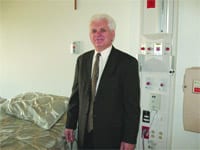Healing Environment — by Design Mercy’s New Intermediate Care Unit Sheds Some Light on the Subject
To officials at Mercy Medical Center who recently cut the ribbon on the hospital’s new intermediate care unit, the space is an ideal blend of state-of-the-art technology and natural healing.
The 22-bed IMCU features private rooms for each patient with direct access to large windows and plenty of natural light. Both, it turns out, are more than mere design choices.
“On one hand, it’s a unit designed to respect a patient’s privacy, and to have a place for family and friends to visit,” said Vincent McCorkle, president and CEO of the Sisters of Providence Health System, which oversees the Springfield-based hospital.
“But when it comes to privacy and things like the use of natural light,” he continued, “clinical studies have demonstrated that they help in the healing process and help patients do better. There’s less disorientation, and patients leave the hospital faster.”
Of course, privacy has become a major concern for hospitals in the era of the Health Insurance Portability and Accountability Act (HIPAA). But Stan Rogalski, vice president of System Support Services, also cited a string of industry studies demonstrating that a patient’s hospital environment — elements like natural light, noise reduction, even the colors used in room décor — can have a measurable impact on healing time and the quality of that healing.
Private rooms are a big part of that equation, and even insurance companies are coming around on the issue, he added, noting that payers that have historically been reluctant to cover private rooms now understand that, when patients recover faster, there are lower costs in the long run.
That’s partly why McCorkle sees the new IMCU as an investment, in more ways than one.
“We look at the demographics of our community and what the community can afford, and at the same time what the community needs in terms of exceptional health care,” he told The Healthcare News. “This is part of a strategy to offer value — a combination of lower cost and excellent clinical quality — improving the overall experience of hospital care for the patient and the family when they come to the intermediate care unit.”
Comforts of Home
Family members and others who visit patients in the new unit will find more space inside patient rooms and in common areas than in the old IMCU. Additional amenities include flat-screen televisions and wi-fi service provided free of charge, as well as adjustable lighting, ceramic-tiled bathrooms, and glass-panel doors for noise reduction.
Such elements, particularly those related to privacy and noise reduction, aren’t new concepts, but they are receiving more attention in hospital design as new data becomes available and is touted by organizations like the California-based Center for Health Design Research (CHDR).
Take, for example, the benefits of private rooms in relation to noise levels. “Hospitals are extremely noisy, and noise levels in most hospitals far exceed recommended guidelines,” writes Dr. Anjali Joseph on the CHDR Web site. “The high ambient noise levels, as well as peak noise levels in hospitals, have serious impacts on patient and staff outcomes ranging from sleep loss and elevated blood pressure among patients to emotional exhaustion and burnout among staff.
“Poorly designed acoustical environments can pose a serious threat to patient confidentiality if private conversations between patients and staff or between staff members can be overheard by unintended listeners,” he adds. “At the same time, a poor acoustical environment impedes effective communication between patients and staff and between staff members by rendering speech and auditory signals less intelligible or detectable.”
Natural light has measurable benefits as well, Joseph notes. “Adequate and appropriate exposure to light is critical for health and well-being of patients as well as staff in health care settings. Natural light should be incorporated into lighting design in health care settings, not only because it is beneficial to patients and staff, but also because it is light delivered at no cost, and in a form that most people prefer.”
The opening of Mercy’s new IMCU — one floor below the hospital’s modern intensive care unit, which opened in 2007 — marks the completion of the first phase of an initiative to create more private rooms and improve the patient experience.
“These improvements are the direct result of input from our patients, many of whom have expressed a desire for more privacy as they recover from illness or injury,” McCorkle said, adding that, increasingly, hospitals need to consider both technological advances and structural design elements when trying to improve patient satisfaction and care.
Phase two of the project will involve the conversion of double rooms to private rooms on other patient care floors at Mercy, significantly increasing the number of single or private rooms available for both medical and surgical patients. One of the areas to see this renovation will be the old intermediate care unit, he said.
Elbow Room
As for the new IMCU rooms, he said patients and their families will be pleased with the space. Even elements unrelated to square footage — like a bank of outlets to hook up monitoring equipment attached to the wall of each room — will save space and reduce chaos.
“The rooms aren’t quite as large as in the ICU, where they have to be bringing in crash carts and teams of people,” McCorkle said. “But there are more rooms here than in the ICU, and they all have very spacious private bathrooms.”
All of which, he said, speaks to an overall goal of patient satisfaction.
“As we tell people these days, if you haven’t seen Mercy lately, you haven’t seen Mercy.”



Comments are closed.